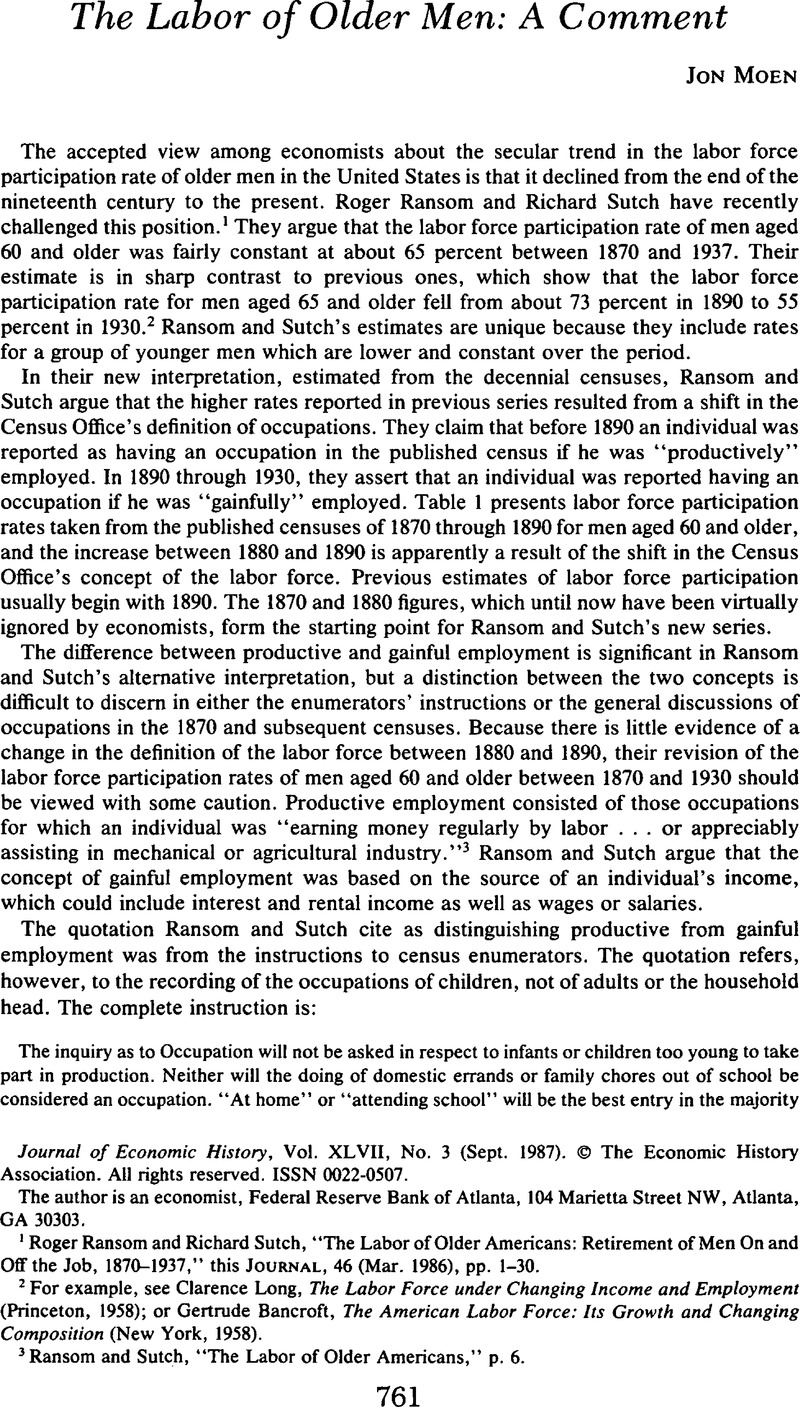Published online by Cambridge University Press: 03 March 2009

1 Ransom, Roger and Sutch, Richard, “The Labor of Older Americans: Retirement of Men On and Off the Job, 1870–1937,” this JOURNAL, 46 (03 1986), pp. 1–30.Google Scholar
2 For example, see Long, Clarence, The Labor Force under Changing Income and Employment (Princeton, 1958);Google Scholar or Bancroft, Gertrude, The American Labor Force: Its Growth and Changing Composition (New York, 1958).Google Scholar
3 Ransom and Sutch, “The Labor of Older Americans,” p. 6.Google Scholar
4 U.S. Bureau of the Census, Twelfth Census, Special Repons: Occupations at the Twelfth Census (Washington, D.C., 1904), pp. ccxlvii–ccii.Google Scholar
5 Ransom, Roger and Sutch, Richard, “The Labor of Older Americans: Retirement of Men On and Off the Job, 1870–1937,” this JOURNAL, 46 (03 1986), pp. ccxlvii–ccxlviii.Google Scholar
6 Ransom and Sutch, “The Labor of Older Americans,” p. 8.Google Scholar
7 U.S. Census Office, Eleventh Census, 1890, Report on thes Population of the United States at the Eleventh Census: 1890, Part 2 (Washington, D.C., 1897), p. cxxvi. The figures on months unemployed were still poor enough in 1890 not to be included in separate tables in the 1890 census. Many enumerators apparently recorded the number of months an individual was unemployed from his primary occupation, not the number of months of unemployment net of other temporary work an individual may have undertaken while unemployed from his primary occupation. The situation was better in the 1900 census.Google Scholar
8 U.S. Census Office, Eleventh Census 1890, Population, p. lxxvi.Google Scholar
9 Ransom and Sutch, “The Labor of Older Americans,” p. 10.Google Scholar
10 For example, see Long, The Labor Force, p. 291.Google Scholar
11 U.S. Bureau of the Census, Fifteenth Census, 1930. Population., vol. 5: “General Report on Occupations” (Washington, D.C., 1933), p. 30. Italics are in the original.Google Scholar
12 Ransom and Sutch, “The Labor of Older Americans,” p. 14.Google Scholar
13 Ransom and Sutch focus on the labor force participation rate of men age 60 and older because the published censuses for 1870 and 1880 report occupations for the age groups 10 to 15, 16 to 59, and 60 and older. I use the age group 65 and older because that is the group reported in the 1890 and subsequent censuses. Furthermore, most of the decline in labor force participation rates of men in 1860 occurred after age 65. I estimate the labor force participation rate of men ages 60 through 64 and find it to be 93 percent. The labor force participation rate of men in the prime working ages of 20 through 59 is 95 percent. Both figures are estimated from the Bateman-Foust sample of rural households. For a description of the Bateman-Foust sample, see Bateman, Fred and Foust, James,“A Sample of Rural Households Selected from the 1860 Manuscript Schedules,” Agricultural History, 48 (01 1974), pp. 75–93. Using the 1900 Public Use Sample, I estimate a rate of 90 percent for men 60 through 64 and a rate of 65 percent for men 65 and older (these were produced without excluding men reporting six or more months of unemployment).Google Scholar
14 Smith, Daniel Scott,“A Community-Based Sample of the Older Population from the 1880 and 1900 Manuscript Census,” Historical Methods, 11 (Spring 1978), pp. 67–74. Smith's sample for 1880 consists of three separate files. The national sample covers 1501 men and women age 65 and older (740 men). The southern black file covers 804 blacks pulls 405 whites in 32 counties in the South. The southern urban black file covers 472 blacks and 315 whites in southern cities having populations over 4000. The labor force participation rates presented here were estimated from the national sample only, in which 87.7 percent of the men were white, 11.1 percent were black, and 1.2 percent other races. The 1880 files are available from the Inter-university Consortium for Political and Social Research (ICPSR study #8427) in Ann Arbor, Michigan.CrossRefGoogle ScholarPubMed
15 Smith, Daniel Scott,“A Community-Based Sample of the Older Population from the 1880 and 1900 Manuscript Census,” Historical Methods, 11 (Spring 1978), pp. 409, 414.CrossRefGoogle ScholarPubMed
16 Achenbaum, W. Andrew, Old Age in the New Land: The American Experience since 1790 (Baltimore, 1978), pp. 179–81.Google ScholarRansom and Sutch claim that Achenbaum provides no explanation for his conclusion. See Ransom and Sutch, “The Labor of Older Americans,” p. 7, fn. 13.Google Scholar
17 Wright, Carroll, History and Growth of the United States Census (Washington, D.C., 1900), pp. 154–55, 157, 166, 171.Google Scholar
18 Ransom and Sutch, “The Labor of Older Americans,”p. 10, fn. 26.Google Scholar
19 Smith, Daniel Scott,“A Community-Based Sample of the Older Population from the 1880 and 1900 Manuscript Census,” Historical Methods, 11 (Spring 1978), p. 14.CrossRefGoogle ScholarPubMed